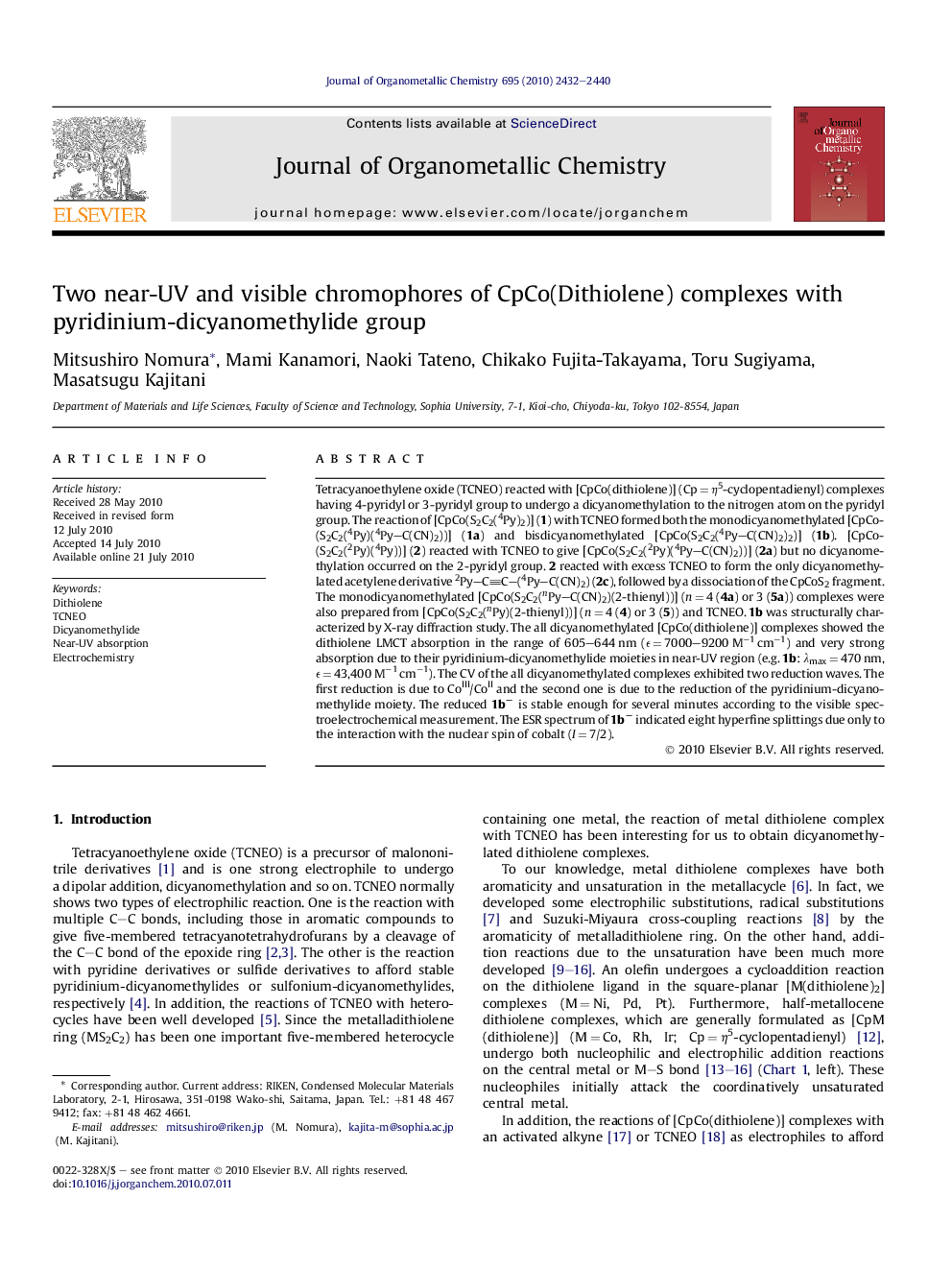| Article ID | Journal | Published Year | Pages | File Type |
|---|---|---|---|---|
| 1325652 | Journal of Organometallic Chemistry | 2010 | 9 Pages |
Tetracyanoethylene oxide (TCNEO) reacted with [CpCo(dithiolene)] (Cp = η5-cyclopentadienyl) complexes having 4-pyridyl or 3-pyridyl group to undergo a dicyanomethylation to the nitrogen atom on the pyridyl group. The reaction of [CpCo(S2C2(4Py)2)] (1) with TCNEO formed both the monodicyanomethylated [CpCo(S2C2(4Py)(4Py–C(CN)2))] (1a) and bisdicyanomethylated [CpCo(S2C2(4Py–C(CN)2)2)] (1b). [CpCo(S2C2(2Py)(4Py))] (2) reacted with TCNEO to give [CpCo(S2C2(2Py)(4Py–C(CN)2))] (2a) but no dicyanomethylation occurred on the 2-pyridyl group. 2 reacted with excess TCNEO to form the only dicyanomethylated acetylene derivative 2Py–CC–(4Py–C(CN)2) (2c), followed by a dissociation of the CpCoS2 fragment. The monodicyanomethylated [CpCo(S2C2(nPy–C(CN)2)(2-thienyl))] (n = 4 (4a) or 3 (5a)) complexes were also prepared from [CpCo(S2C2(nPy)(2-thienyl))] (n = 4 (4) or 3 (5)) and TCNEO. 1b was structurally characterized by X-ray diffraction study. The all dicyanomethylated [CpCo(dithiolene)] complexes showed the dithiolene LMCT absorption in the range of 605–644 nm (ε = 7000–9200 M−1 cm−1) and very strong absorption due to their pyridinium-dicyanomethylide moieties in near-UV region (e.g. 1b: λmax = 470 nm, ε = 43,400 M−1 cm−1). The CV of the all dicyanomethylated complexes exhibited two reduction waves. The first reduction is due to CoIII/CoII and the second one is due to the reduction of the pyridinium-dicyanomethylide moiety. The reduced 1b− is stable enough for several minutes according to the visible spectroelectrochemical measurement. The ESR spectrum of 1b− indicated eight hyperfine splittings due only to the interaction with the nuclear spin of cobalt (I = 7/2).
Graphical abstractThe reaction of [CpCo(S2C2(4Py)2)] (1) with TCNEO formed both the monodicyanomethylated [CpCo(S2C2(4Py)(4Py–C(CN)2))] (1a) and bisdicyanomethylated [CpCo(S2C2(4Py–C(CN)2)2)] (1b). The all dicyanomethylated [CpCo(dithiolene)] complexes showed the dithiolene LMCT absorption in the range of 605–644 nm (ε = 7000–9200 M−1 cm−1) and very strong absorption due to their pyridinium-dicyanomethylide moieties in near-UV region (e.g. 1b: λmax = 470 nm, ε = 43,400 M−1 cm−1). The electrochemically generated 1b− is stable enough for several minutes according to visible spectroelectrochemical measurement. The ESR spectrum of 1b− indicated eight hyperfine splittings due only to the interaction with the nuclear spin of cobalt (I = 7/2).Figure optionsDownload full-size imageDownload as PowerPoint slide
